NOVEMBER 2016 UPDATE – TO SEE OUR LATEST ARTICLE ON THE NEW GOPRO HERO 5 CAMERAS, PLEASE CLICK HERE!
In October 2014, GoPro introduced its Hero 4 range of cameras – the Hero 4 Silver, featuring a built-in touch LCD for around $400, and the range-topping Hero 4 Black at around $500, which lacks the screen, but features 4K resolution at 30 fps (double that of the previous Hero 3+ Black, which has now been discontinued).
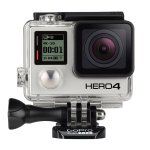 The two new cameras present something of a dilemma to the user looking to buy a GoPro for the first time, or to upgrade from a previous model. While GoPro are continuing to make the Hero 3 White and Hero 3+ Silver cameras, and have introduced the new entry-level GoPro Hero (all of which we’ve covered in our range overview here), those who are keen to get the newest and most fully-featured cameras will have to chose between either having a built-in screen, or the ability to shoot at 4K resolution.
The two new cameras present something of a dilemma to the user looking to buy a GoPro for the first time, or to upgrade from a previous model. While GoPro are continuing to make the Hero 3 White and Hero 3+ Silver cameras, and have introduced the new entry-level GoPro Hero (all of which we’ve covered in our range overview here), those who are keen to get the newest and most fully-featured cameras will have to chose between either having a built-in screen, or the ability to shoot at 4K resolution.
However, these headline features can also have knock-on effects in other areas of the cameras’ performance. As such, we’ve carried out a fully detailed breakdown of the differences between the Hero 4 Silver and Hero 4 Black, to help you determine which one best suits your needs.
Addition features over the Hero 3 and 3+ range
As a starting point, it is useful to note the additional features which the GoPro Hero 4 range has above the previous Hero 3 (White) and Hero 3 + (both the Silver and now-discontinued though still available Black) cameras:
- Bluetooth in addition to a wifi connection. The immediate benefits of this aren’t immediately clear, since the smartphone app and the remote control both use wifi, but it may open the door for new types of connection in the future. In addition, it appears that the wifi speed has been improved.
- Improved user interface – while the GoPro has the same number of buttons it had previously, the side button (previously for toggling wifi on or off) now brings up a context-sensitive menu of options which change depending on what mode the camera is currently set it
- Night photo facility – the night photo setting allows the user much more control the shutter speed, with exposures of up to 30 seconds possible – and this can also be used in a time lapse mode to create some awesome night-time images.
- Protune mode now available for photos as well as videos
- Improved audio capture – GoPro claim a 2x increase in dynamic range compared to the Hero 3 and 3+.
Physical size
Although it would be understandable if the inclusion of the LCD screen had made the GoPro Hero 4 Silver deeper and/or heavier, this is not in fact the case. Indeed, GoPro quote the weight of the Hero 4 Black as being 0.2 oz (5g) heavier than the Silver – not that it is likely anyone will notice such a small difference! As such, both the 4 Silver and the Black fit into GoPro’s standard housing (in common with the Hero 3 and 3+ models), and – with the standard backdoors – are waterproof to 40m. However, the Hero 4 Silver also ships with a touch backdoor, which enables the LCD touchscreen to be used, but is only waterproof to a depth of 3m.
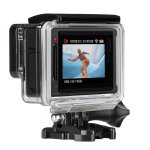 Clearly, the inclusion of the screen on the GoPro Hero 4 is its most obvious distinguishing feature. The screen functions in the same way as that on the Touch BacPac module, but is much more neatly integrated than it would be if you attached the BacPac to any other GoPro model. It is, however, a fair bit smaller than the BacPac screen, though it appears to be the same pixel resolution (although GoPro haven’t published the figures on this). It should also be noted that the BacPac retails for around $80, so adding one to (for example) the GoPro Hero 3+ costs nearly as much as buying a Hero 4 Silver, and without the additional benefits that the Hero 4 brings in terms of resolution and functionality. As such, if the screen is something you really want, then we’d suggest going straight for the Hero 4 Silver – that is unless you really need the power of the Hero 4 Black!
Clearly, the inclusion of the screen on the GoPro Hero 4 is its most obvious distinguishing feature. The screen functions in the same way as that on the Touch BacPac module, but is much more neatly integrated than it would be if you attached the BacPac to any other GoPro model. It is, however, a fair bit smaller than the BacPac screen, though it appears to be the same pixel resolution (although GoPro haven’t published the figures on this). It should also be noted that the BacPac retails for around $80, so adding one to (for example) the GoPro Hero 3+ costs nearly as much as buying a Hero 4 Silver, and without the additional benefits that the Hero 4 brings in terms of resolution and functionality. As such, if the screen is something you really want, then we’d suggest going straight for the Hero 4 Silver – that is unless you really need the power of the Hero 4 Black!
There are two key advantages of having the screen. Firstly, it allows the GoPro to be used much more as an ultra-compact but ‘normal’ video camera – you can frame up your shots, and review the images as you are taking them. This moves the GoPro away from simply being an action cam, and into being a more full-featured camera which has the additional ability to be mounted as an action camera. Certainly, in situations where you would plan to hold and aim the camera in the direction that you are looking in (scuba diving for example), as opposed to having the camera fixed on a static mount or looking towards you, the addition of the screen is likely to make a lot of sense. Indeed, as we commented in our review of the LCD Touch BacPac, a GoPro with a screen such as the Hero 4 Silver could potentially remove the need to carry another ‘proper’ camera on a lightweight trip – the GoPro can serve both roles.
The other advantage of the screen is usability. Having the screen means changing the camera’s setup, and reviewing the footage already taken, can be achieved quickly and easily, and without having to first dig out your smart phone and make a wifi connection. This is particularly beneficial when you’re shooting in tough environments where you don’t necessarily want to get your smartphone out, or even have it with you in the first place.
The key potential disadvantage of the screen is the additional battery power it can use up. However, to a very large extent, this is governed by how much the screen is actually used. The Hero 4 Silver features a button to the lower left of the screen (as can be seen in the photo here) which can be used to 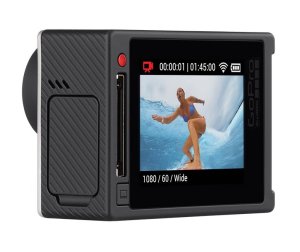 toggle the display on and off, so it is possible to turn it off when it is not being used. However, this button does not feature a ‘through the case’ actuator, and so you would need open any waterproof housing in order to do this, which limits the usefulness of the button somewhat. In addition, the Silver has a setup menu option to turn the screen off altogether, which is can be handy where power drain is a real concern, or where the screen is simply not relevant to a particular shooting position. As such, users do have a reasonable ability to control how much power the screen is allowed to use up. In this context, it’s hard to see the presence of the screen as a disadvantage in any way – just something to be aware of in relation to battery life.
toggle the display on and off, so it is possible to turn it off when it is not being used. However, this button does not feature a ‘through the case’ actuator, and so you would need open any waterproof housing in order to do this, which limits the usefulness of the button somewhat. In addition, the Silver has a setup menu option to turn the screen off altogether, which is can be handy where power drain is a real concern, or where the screen is simply not relevant to a particular shooting position. As such, users do have a reasonable ability to control how much power the screen is allowed to use up. In this context, it’s hard to see the presence of the screen as a disadvantage in any way – just something to be aware of in relation to battery life.
Video modes
| Resolution | GoPro Hero 4 Silver | GoPro Hero 4 Black |
|---|---|---|
| 4k | 15 fps Ultra-wide FOV | 30 fps Ultra-wide FOV Superview option (at 24 fps) |
| 2.7K | 30 fps Ultra-wide or medium FOV | 50fps Ultra-wide or medium FOV Superview option (30 fps) |
| 1440p | 48 fps ultra-wide FOV (4:3 aspect ratio) | 80 fps ultra-wide FOV (4:3 aspect ratio) |
| 1080p | 60 fps Ultra-wide, medium & narrow FOV Superview option (at 60 fps) | 120 fps Ultra-wide, medium & narrow FOV Superview option (at 80 fps) |
| 960p | 100 fps Ultra-wide FOV (4:3 aspect ratio) | 120 fps Ultra-wide FOV (4:3 aspect ratio) |
| 720p | 120 fps Ultra-wide, medium & narrow FOV Superview option (at 100 fps) | 240 fps in narrow FOV 120 fps in ultra-wide & medium FOV Superview option (at 120 fps) |
| WVGA | 240 fps Ultra-wide FOV | 240 fps Ultra-wide FOV |
| Still photos | 12 megapixels Ultra-wide angle 30 photos a second burst for up to 3 seconds 10 photos a second possible for up to 30 seconds 2 photos a second time lapse | 12 megapixels Ultra-wide angle 30 photos a second burst for up to 3 seconds 10 photos a second possible for up to 30 seconds 2 photos a second time lapse |
As can be seen from the table below, the key message on video resolutions is that anything the GoPro Hero 4 Silver can do, the Hero 4 Black can do better… or at least at a higher framerate!
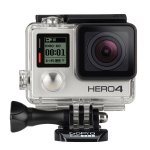 Starting from the top, it is notable that the Hero 4 Silver does have a 4K video mode. This is interesting because this point seems to be buried away in all of GoPro’s marketing – they lead by stating that it “captures 1080p60 and 720p120 video with lifelike clarity, plus 12MP photos at a staggering 30 frames per second” – there is no mention of the 4K mode until you dig down into the technical specs. There are potentially two reasons for this: Firstly, GoPro does not want to dilute down the impact of its Black model being the flagship 4K model; and secondly, it is potentially a tacit admission that 4K at only 15 fps cannot really be considered as ‘true’ 4K resolution. If that is indeed the rationale, then we would agree with it. 15 fps video is too choppy to be of any real use, particularly in the context of action sports where smooth, fluid motion is everything. While it might be possible to utilise the 4K mode on the GoPro Hero 4 Silver as a kind of ‘ultra timelapse’ mode and look to use the resulting 3840 x 2160 pixel frames as still images, for most users a higher framerate is likely to be necessary.
Starting from the top, it is notable that the Hero 4 Silver does have a 4K video mode. This is interesting because this point seems to be buried away in all of GoPro’s marketing – they lead by stating that it “captures 1080p60 and 720p120 video with lifelike clarity, plus 12MP photos at a staggering 30 frames per second” – there is no mention of the 4K mode until you dig down into the technical specs. There are potentially two reasons for this: Firstly, GoPro does not want to dilute down the impact of its Black model being the flagship 4K model; and secondly, it is potentially a tacit admission that 4K at only 15 fps cannot really be considered as ‘true’ 4K resolution. If that is indeed the rationale, then we would agree with it. 15 fps video is too choppy to be of any real use, particularly in the context of action sports where smooth, fluid motion is everything. While it might be possible to utilise the 4K mode on the GoPro Hero 4 Silver as a kind of ‘ultra timelapse’ mode and look to use the resulting 3840 x 2160 pixel frames as still images, for most users a higher framerate is likely to be necessary.
In this regard, the Hero 4 Black can genuinely be regarded as the first ‘true’ 4K video GoPro, shooting as it does 4K at 30 fps, or at 24 fps in SuperView mode as discussed below. The footage it takes in this setting is truly outstanding, though as we’ve previously noted, you will need a computer or TV capable of displaying 4K resolution to take advantage of this. Clearly though, as time goes on these are becoming more and more common, and indeed Apple’s flagship iMac now comes with a 5K 27 inch display – an ideal companion for the GoPro 4 Black if you can afford it!
Working down the video modes, the overall trend is that the GoPro 4 Black more or less doubles the framerate available at any given resolution. It’s worth noting that the Hero 4 Silver can shoot at 30fps at 2.7k (vs 60fps for the Black), so a usable video framerate is available on the Silver at a ‘greater than HD’ resolution. Even if the final edit will be at 1080p rather than 2.7k, this resolution provides some additional ‘futureproofing” of the footage, and gives the ability to crop down within the frame; however, the 30fps framerate provides no real capability to slow the footage down at this resolution.
Moving down to the ‘full HD’ resolution of 1080p, the Black is capable of 120 fps, versus the Silver’s 60 fps. The key advantage of the Black here is that 1080p120 footage can be slowed down by a factor of four while still maintaining a framerate of 30fps, and thus looking smooth to the human eye. This allows true ultra slow-motion to be captured, and in some respects is as impressive a setting as the 4K resolution.
Dropping back to the 720p video mode, what is interesting is that the Hero 4 Black’s performance has been boosted in between product releases via a firmware updated in February 2015. Prior to this firmware release, it was the Silver vs Black framerate doubling rule had ceased to apply at 720p – both cameras could shoot at a maximum of 120fps. However, with the new firmware, the Black can now shoot at a huge 240fps at 720p, albeit only in the ‘narrow’ field of view setting. This means that HD footage can be slowed down by a factor of eight (240fps to 30fps). In combination with the 1080p120 capability discussed above, this is potentially a considerable advantage for the GoPro Hero 4 Black over the Silver if slo-mo footage is something that interests you. 240fps is available on the Silver at WVGA resolution (848 by 480 pixels) – this can make for some fun effects, but the relatively low resolution means it’s unlikely to be a mode that many users a lot.
It’s interesting to note that the frame rates on both the Black and the the Silver drop somewhat when the SuperView mode (explained further here) is being used – though not at all the resolution settings:
On the GoPro Hero 4 Black:
- 4K Superview is down from 30fps to 24 fps
- 1080p Superview is down from 120 fps to 80 fps
On the GoPro Hero 4 Silver:
- 1080p Superview framerate doesn’t change – it stays at 60 fps.
- 720p Superview drops from 120fps to 100fps
GoPro doesn’t comment on these differences, but we assume it is due to the additional processing power required to deal with the SuperView setting means that, at some resolutions where the camera is already “maxed out” it cannot ingest quite as many frames a second. It’s unlikely to be an issue for most users, though it does mean that a choice needs to be made between the ultimate 120 fps slow motion effect and the use of SuperView on the Black at 1080p, and the Silver at 720p.
Still photos
On the still photograph front, the GoPro 4 Silver and Black have identical specs – 12 megapixels, with a maximum three-second burst of 30 photos a second, or a thirty-second run of 10 photos a second. There is also a useful time-lapse mode, which can produce particularly good results when paired with a rotating time-lapse tripod mount. It is worth bearing in mind that the Silver’s built-in LCD is likely to be a significant advantage if you plan on using the camera for a lot of still photos.
Audio
The basic audio specs are the same between the GoPro Hero 4 Silver and Black – each has a sampling rate of 48kHz, uses a mono internal microphone, and compresses into an AAC format. Each camera can also be used with a separately available USB to 3.5mm jack adapter so that a stereo microphone can be plugged in (though this does necessitate using the skeleton housing.
However, the Black has one additional audio trick up its sleeve – it also features an analogue to digital converter to allow it to be used with a number of studio quality microphones. This feature is something which is only really likely to appeal to professionals – the vast majority of users are satisfied with the sound quality from the internal mono mic, or indeed plan to mute the audio track anyway and replace it with some music!
SuperView and Protune
There is nothing really to call between the GoPro 4 Silver and Black here – both feature the SuperView setting (though note that at a 4K resolution, this is only available on the Black, not the Silver), and both feature GoPro’s Protune settings which allow video to be recorded in a less compressed format which is more suitable for professional post-production. In general, users who are likely to need to use Protune will probably know all about it already – anyone who isn’t sure quite what it is for is probably best advised to leave it alone and stick with the standard output straight from the camera – this looks much better than the unprocessed Protune video, which is (deliberately) flat and with somewhat muted colours.
Battery life
Both the GoPro Hero 4 Silver and Black feature the same 3.8V, 4.4Wh battery pack. GoPro has published figures for the recording times which can be expected from a fully charged battery, and the table below sets out a comparison of the Silver and the Black in various recording modes when the cameras are used without activating the wifi function:
| Resolution | GoPro Hero 4 Silver | GoPro Hero 4 Black |
|---|---|---|
| 4K 30fps | - | 1 hr 5 min |
| 4K 15fps | 2 hr 0 min | - |
| 2.7K 30fps | 1 hr 50 min | 1 hr 10 min |
| 1080p 120fps | - | 1 hr 10 min |
| 1080p 60fps | 1 hr 40 min | 1 hr 20 min |
| 1080p 30fps (SuperView) | 1 hr 50 min | 1 hr 30 min |
| 720p 120fps | 1 hr 55 min | 1 hr 50min |
Before diving into the comparison, a few ‘health warnings’. Firstly, GoPro has referred to these times as “continuous recording times” – this suggests they represent the cameras being turned on with a fresh battery, immediately triggered to start a single recording, and then left alone until the battery expires. While it is understandable that GoPro have had to standardise their testing like this, it is not likely to reflect very accurately how a GoPro will actually be used – this is likely to involve much more powering on and off, starting and stopping recording, changing the settings and – crucially in the case of the Hero 4 Silver – reviewing footage on the Touch LCD screen. In addition, while GoPro don’t state the temperature at which their tests were carried out, you can bet that it was at a comfortable room temperature. When you’re out and about filming, and especially if you’re using the camera for winter sports, the cold is going to have a real impact on the battery life. As such, the figures quoted above are very likely to represent best case scenarios.
With that in mind, the battery life figures for both cameras make quite sobering reading. At 4K and 30fps, the GoPro 4 Black barely manages over an hour of recording time – in the real world and with broken-in batteries, that figure is almost certain to fall to under 60 minutes. Even dropping down to 1080p at 60fps, the Black model only ticks up to 1 hour 20 minutes. At this resolution and framerate, the Silver manages 20 minutes (25%) more on paper at least, though as noted above this likely does not factor in any use of its 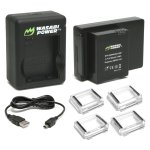 screen. The truth of the matter is that neither camera offers a setting which promises more than 2 hours of recording in optimum conditions, whereas (for example) the lower spec GoPro Hero 3 White offers 3 hours in some settings. The upshot of all this is that you are highly likely to want to invest either in some spare batteries and a charger, or (for the Black at least, since it would cover the screen on the Silver) the GoPro Battery BacPac, or one of the third party alternatives such as the Wasabi Power Extended Battery.
screen. The truth of the matter is that neither camera offers a setting which promises more than 2 hours of recording in optimum conditions, whereas (for example) the lower spec GoPro Hero 3 White offers 3 hours in some settings. The upshot of all this is that you are highly likely to want to invest either in some spare batteries and a charger, or (for the Black at least, since it would cover the screen on the Silver) the GoPro Battery BacPac, or one of the third party alternatives such as the Wasabi Power Extended Battery.
Conclusion and recommendations
So, which model is best for you? Well, as ever, it comes down to what your priorities are. If you own (or plan to own shortly) a 4K-capable television or computer, and if the money is burning a hole in your pocket, then the GoPro Hero 4 Black is a superb bit of kit – its true 4K resolution is magnificent and – at the moment – there is no other action camera that comes close. In addition, if you are super-keen on liquid slow motion video then the Black’s 1080p 120 fps and 720p 240fps modes will not disappoint. But $500 is a significant price, and you’ll also need to budget for some extra batteries or an extended power pack as discussed above.
For what is likely to be the majority of users however, the GoPro Hero 4 Silver may well hit the sweet spot. It still serves up future proof and usable greater-than-HD video at 2.7K / 30 fps, while those in the mode for slow motion can still achieve 120 fps (albeit only at 720p rather than 1080p). Fundamentally however, the inclusion of a rear screen is a game changer for GoPro – suddenly it has become so much more of a usable camera, and is capable of being deployed in a much wider range of scenarios. In addition, the screen allows brilliant access to the multitude of modes and settings that GoPro now offer, without having to fire up the wifi and connect it to your smartphone. All this, and for $100 less than the GoPro Hero 4 Black. The only downside of the screen is that if you use it too much it will seriously dent the battery life. However, there are ways to limit the screen’s use, and the issue can be avoided altogether with a few spare batteries and a battery charger. As such, the GoPro Hero 4 Silver would be our pick.
We hope you’ve found this article useful! If you’re ready to buy a GoPro (or anything else for that matter) and click on one of the Amazon links above (or here) then this website earns a small commission on any purchase you make – though it doesn’t cost you any more! And do let us know if you have any questions or comments below. Thanks!
NEW – our unboxing video for the GoPro Hero 4 Silver:
